Family : Carangidae

Text © Giuseppe Mazza

English translation by Mario Beltramini
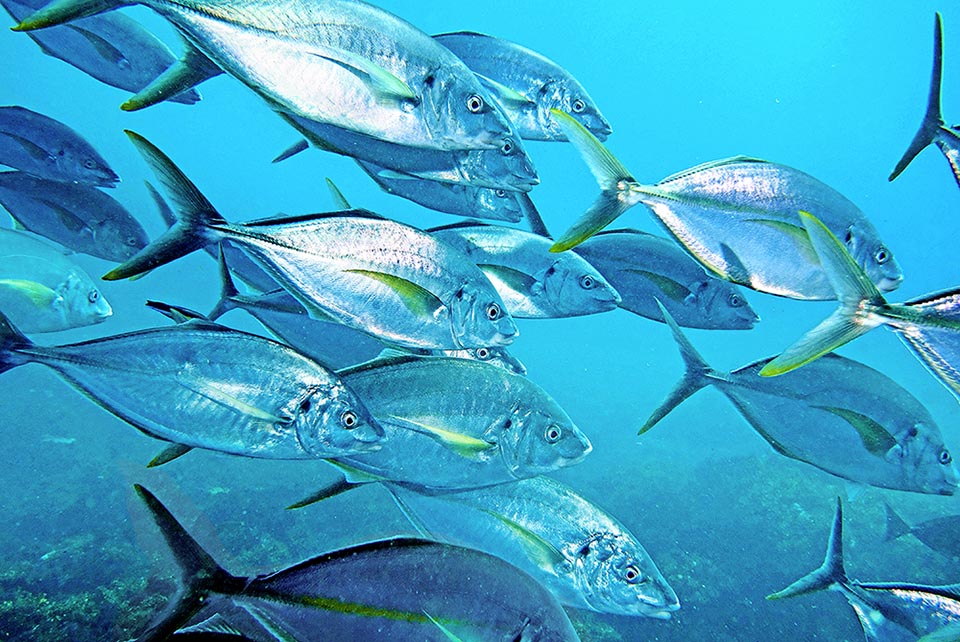
Present in the tropical and subtropical waters of all oceans, Pseudocaranx dentex is an overfished species that moves in schools © John Turnbull
The White trevally (Pseudocaranx dentex Bloch & Schneider, 1801) belongs to the class of the Actinopterygii, the ray finned fishes, to the order of the Perciformes and to the family of the Carangidae, that counts about 30 genera and more than 140 species.
The name of the genus comes from the Greek “pseudes” = false, apparently similar, and from the known genus Caranx (Lacepède, 1801) that, with more than 200 species, has originated the family.
The specific term “dentex” evokes, due to the profile of the head and the big lips, the genus Dentex, (Cuvier, 1814) that however belongs to the family of the sparids.
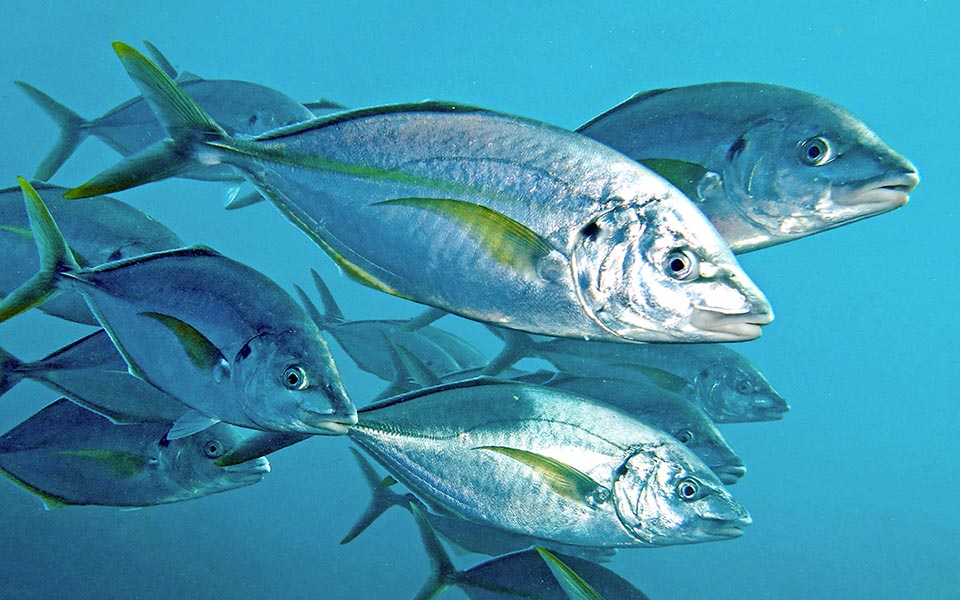
Rare in Mediterranean, preys on fishes and mollusks swimming along coasts eating also plankton and benthic animals, like crustaceans, echinoderms, worms and bivalves © John Turnbull
Zoogeography
Present in the tropical and subtropical waters of all the oceans, rare in the Mediterranean, the white trevally has its maximum diffusion in Oceania, along the coasts of Mexico, of Namibia, of Hong Kong and in the Ogasawara Islands.
Ecology-Habitat
Pelagic species, it avoids the cold waters and almost never swims in high seas. It moves mainly along the coasts, usually between 10-25 m of depth, even if it has been found at 238 m.
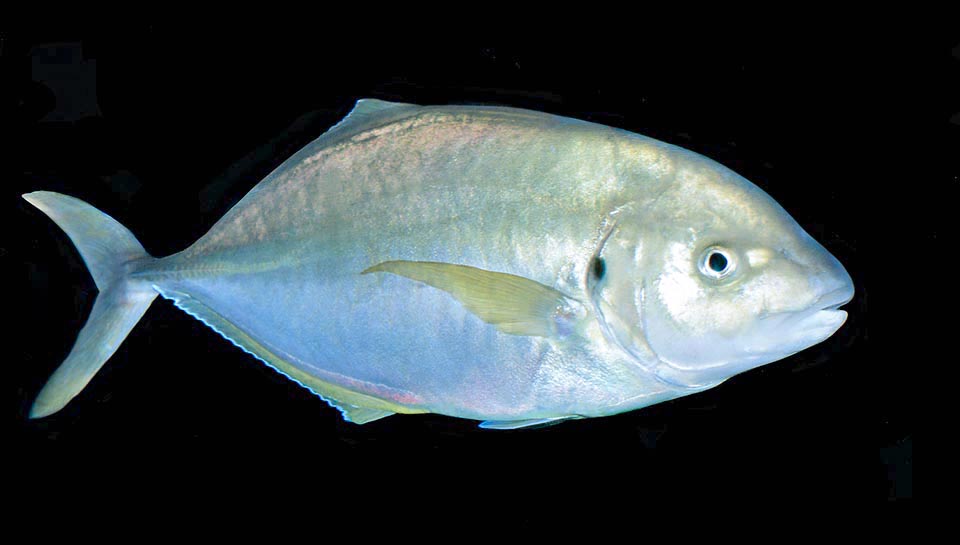
It moves fast usually at 10-25 m of depth, and can go even lower, with a sighting reported at 238 m © Giuseppe Mazza
Perfectly at ease among the corals, does not disdain, especially when young, the brackish and murky waters of the estuaries and usually shows a particular liking for the small islands.
Morpho-physiology
Unlike many Carangidae the muzzle is not snub and the second dorsal fin and the anal are not falcate. The body, flat and oval, is protected by tiny scales that extend up to over the operculum. Even if usually the catch is about 40 cm, the Pseudocaranx dentex may exceed the metre of length with a record at 122 cm and a weight of 18,1 kg.
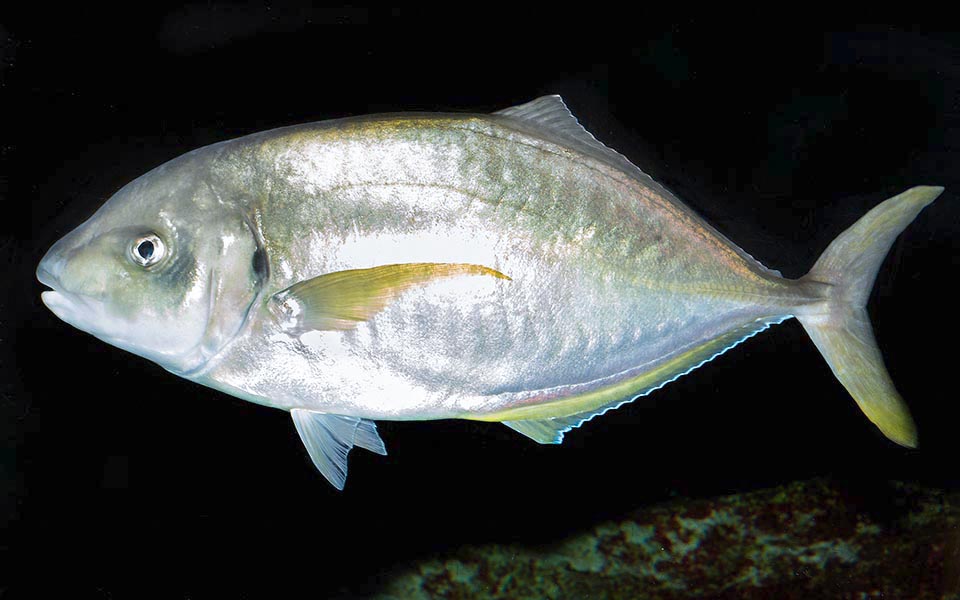
The catch measures about 40 cm, but may exceed the metre of length reaching 122 cm and 18,1 kg © Giuseppe Mazza
The mouth is relatively small and does not reach the level of the eye. The mandibular part is lightly shorter than the maxilla. In the adults both do show only one range of tiny teeth, whilst in the young there is a second row and are noted other tiny teeth on the tongue and on the palate. The lateral line is made of 26-30 pointed bony scutes. The dorsal fins are 2. The first, often folded, is a defense weapon with 8 solid spiny rays. The second has only one spiny ray and 25-26 unarmed. The two anal fins are similar: the first with 2 spiny rays and the second with 1 spiny ray and 21-23 unarmed.
The pectoral fins, falcate with 18-21 rays, are golden yellow more or less like the other fins, hence the Spanish name of “jurel limón” (lemon trevally), and do not reach the lateral line. The ventral fins have one spiny ray and 5 unarmed. The caudal is forked.
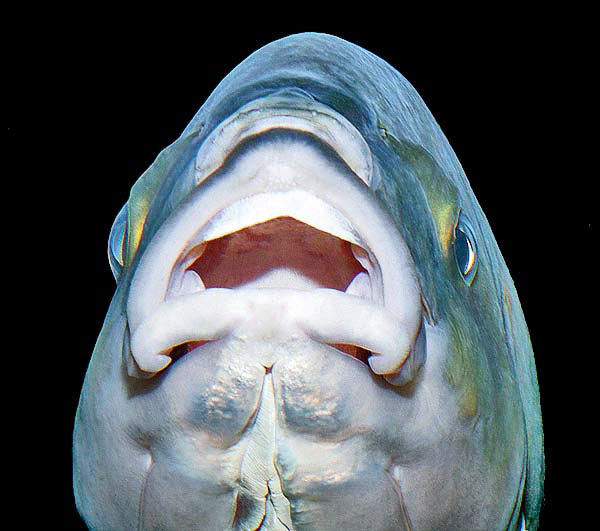
Big lips, but don’t look for the sharp Dentex dentex teeth, resemblance stops here © Giuseppe Mazza
The ground colour is iridescent with golden reflections, bluish, greenish and pinkish. Typical is the black spot on the upper-rear margin of the operculum. The iris is silvery.
Ethology-Reproductive Biology
Gregarious and fast fish, the Pseudocaranx dentex is a predator with a very ample diet: fishes and molluscs of the nekton, but also bottom animals such a worms, crustaceans, echinoderms and bivalves.
The time and the modalities of the reproduction are yet to be thouroughly investigated. The eggs are entrusted to the currents and the larvae, that nourish of zooplankton, reach the 4 cm when 2-3 months old with a life expectancy of almost 50 years.
It is overfished, even if the resilience is good with populations that could double in 1,4-4,4 years.
The fishing vulnerability index in fact marks 73 on a scale of 100 and considering that we have no precise data about the tendency of the populations, Pseudocaranx dentex appears nowadays as “Least Concern” in the Red List of the endangered species.
Synonyms
Scomber dentex Bloch & Schneider, 1801; Caranx dentex Bloch & Schneider, 1801; Trachurus imperialis Rafinesque, 1810; Caranx luna Geoffroy Saint-Hilaire, 1817; Citula banksii Risso, 1820; Caranx solea Cuvier, 1833; Caranx analis Cuvier, 1833; Caranx georgianus Cuvier, 1833; Usacaranx georgianus Cuvier, 1833; Caranx platessa Cuvier, 1833; Longirostrum platessa Cuvier, 1833; Caranx lutescens Richardson & Solander, 1843; Scomber lutescens Solander, 1843; Scomber micansSolander, 1843; Scomber platinoides Solander, 1843; Caranx cestus Richardson, 1846; Caranx nobilis Macleay, 1881; Usacaranx nobilis Macleay, 1881; Caranx delicatissimus Döderlein, 1884; Longirostrum delicatissimus Döderlein, 1884; Carangus cheilio Snyder, 1904; Caranx cheilio Snyder, 1904; Pseudocaranx cheilio Snyder, 1904; Caranx natalensis Gilchrist & Thompson, 1911; Usacaranx archeyi Griffin, 1932.
→ For general information about FISH please click here.
→ For general information about BONY FISH please click here
→ For general information about CARTILAGINOUS FISH please click here.
→ To appreciate the BIODIVERSITY of BONY FISH please click here.
→ To appreciate the BIODIVERSITY of CARTILAGINOUS FISH please click here.
